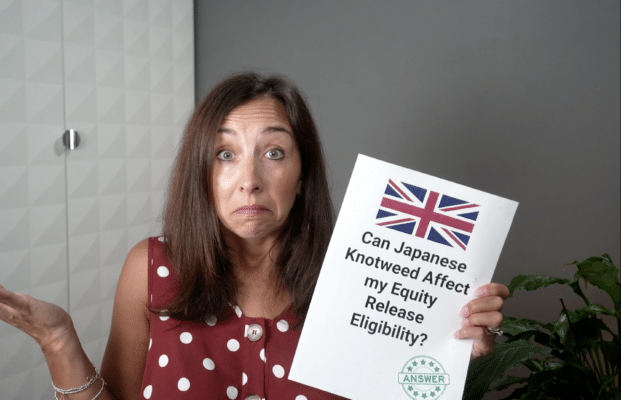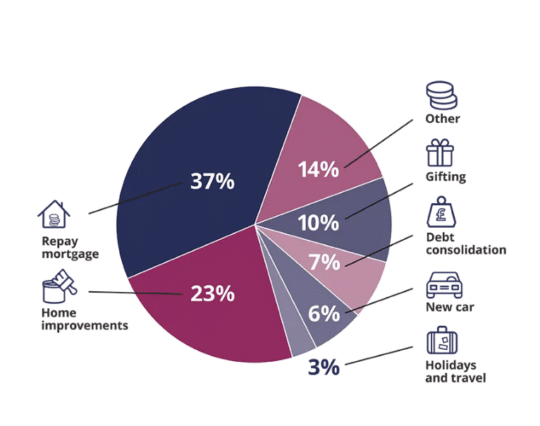Can Japanese Knotweed Affect my Equity Release Eligibility?
Our preferred equity release adviser is Age Partnership. For free and impartial money advice you can visit MoneyHelper.

Our preferred equity release adviser is Age Partnership. For free and impartial money advice you can visit MoneyHelper.
Japanese knotweed is a particularly invasive plant that can cause structural damage to buildings. As a result, an affected property may be ineligible for equity release, albeit this is not always the case.
Repaying an equity release provider usually entails selling your house when the agreement expires. That is why, while assessing an equity release application, providers will consider anything that could damage the future value or saleability of your house. The presence of Japanese knotweed is one example.
In this article, I will look at what Japanese knotweed is, why it is such a big problem and whether it affects your eligibility for equity release. Let’s take a look in more detail.
What is Japanese knotweed?
Before we delve into why it causes so many issues with properties and Japanese knotweed eligibility equity release, it is important to know what Japanese knotweed actually is.
You have probably heard of it through the media because it is a pretty big problem. You may have heard of it described as a monster plant, growing several feet every single day and completely taking over properties.
It sounds like something from a sci-fi film, doesn’t it?
The scary thing is, it isn’t that far from the truth – it really does grow fast and takes over, but it is now thought that some of the horror stories are just that – exaggerated stories.
In the nineteenth century, Japanese Knotweed (Fallopia japonica) was introduced to the United Kingdom as a decorative plant by Philip Von Siebold, who had no idea of the issues it could cause. After all, it looks quite nice!! However, infestation has become a serious issue because of how invasive and difficult to eradicate it has proven to be.
Since it has become such a concern, Schedule 9 of the Wildlife and Countryside Act of 1981 makes it illegal to grow Japanese knotweed in the wild intentionally.
Japanese knotweed may die back to the ground during the winter, but its rhizomes can extend several metres underground, allowing it to easily re-establish itself in the spring. Its bamboo-like stems can reach heights of nearly two metres by early summer.
Gardeners and homeowners everywhere have a major issue with Japanese knotweed. In addition to stifling the growth of other plants, it can disrupt plumbing and lead to costly repairs.
Having Japanese knotweed in your garden is not against the law. You should, however, try to rein it down so that it doesn’t become a problem in your area, as required by the Anti-Social Behaviour, Crime, and Policing Act of 2014.
What does Japanese Knotweed look like?
Japanese knotweed is a herbaceous plant that blooms in the early summer with white flowers and green, heart-shaped leaves.
This invasive plant is easily recognised by its hollow, bamboo-like stems, which can reach heights of 12 feet or more if left to grow.
Japanese knotweed plants produce tiny spiked clusters of purple, pink and red flowers from spring through October.
Furthermore, the stalk maintains its upright position throughout the winter, eventually dying back in the spring.
There are many diverse species, and they all have their own unique traits, such as the ability to produce huge blackberries on their stalks or the presence of wire-like hairs.
| Height | <2-3 metres |
| Stem | Hollow stems that look similar to bamboo. Covered in purple speckles. New growth is red/purple, winter stems are orange/brown and brittle. |
| Leaf | Shield-shaped, green when mature, red when new. Can grow up to 12cm in length. |
| Flower | Small cream/white flowers |
| Rhizome | Roots range from a couple of mms to 20cm in diameter. |
How equity release could help
More than 2 million people have used Age Partnership to release equity since 2004.
How your money is up to you, but here’s what their customers do…
Find out how much equity you could release by clicking the button below.
In partnership with Age Partnership.
Why do some lenders refuse applications with Japanese Knotweed on the property?
Walls and foundations are particularly vulnerable to Japanese knotweed’s destructive invasiveness. Drainage and sewage systems are also vulnerable to this. Therefore, it can reduce the property’s marketability and value.
When selling a home, the seller must verify that Japanese knotweed does not exist in the garden. If so, the seller must provide evidence to the purchaser that steps have been taken to eradicate it.
Since equity release companies see an infestation as too significant a risk, they are hesitant or unwilling to lend against homes affected by Japanese knotweed, thus affecting Japanese knotweed eligibility equity release.
When lending money to customers, service providers constantly run the danger of losing it. When your property is sold, they will only get back what they put into it. Unlike with conventional mortgages, they won’t be guaranteed a steady stream of monthly payments to recoup their investment.
In order to feel comfortable investing in your proposal, providers will want to know that the property will be marketable when it is completed. They will also want to make sure the worth is sufficient to pay back the principal and interest on the loan.
This means that Japanese knotweed is just one of several criteria that can determine whether or not your home qualifies for equity release.
» TAKE ACTION NOW: Find out how much equity you could release
Where is Japanese Knotweed found?
This fast-spreading invasive weed can be seen growing along roadways, riverbanks, next to waterways, and in abandoned areas across Europe.
The United Kingdom and neighbouring countries with temperate climates like France, Belgium, and Ireland are ideal locations for the weed to flourish.
The most common locations for Japanese knotweed in the United Kingdom are the southwest counties of Cornwall and Devon, as well as the south Wales cities of Swansea and Cardiff.
Knotweed has also been spotted in the Scottish cities of Glasgow, Edinburgh, and Dundee, albeit with less regularity.
What problems does Japanese Knotweed cause?
It is possible for Japanese Knotweed to cause damage to:
- Subterranean infrastructure — As it grows, Japanese knotweed may squeeze through even the smallest of openings in pipes, eventually bursting them.
- The most common place for Japanese knotweed damage to appear is on hard surfaces like asphalt. Japanese knotweed may easily break through asphalt, patio slabs, and driveway block paving in its relentless pursuit of sunlight. Japanese knotweed can basically grow up through anything that allows water to drain down into it.
- Although concrete is durable, it cannot support the growth of anything, not even Japanese knotweed. It seeks out vulnerable areas, breaks through them, and grows in size as it progresses through their defences.
- Structures – Japanese knotweed may cause extensive damage to buildings if allowed to take root and spread.
- Boundary walls – Japanese knotweed may be a major problem for fences and even walls if it is allowed to spread unchecked.
- Japanese knotweed can drive the two skins of a cavity wall apart because it can grow up and through vents and air bricks located two metres above the ground.
Now we know a little more about what Japanese knotweed is, what it looks like and why it causes so many problems, let us take a look at how it affects eligibility for equity release.
How do you get rid of Japanese Knotweed?
Japanese knotweed can be eradicated by severing the root system and pulling up the plants above ground.
Other efficient ways include burning, digging up, or the use of pesticides; nevertheless, it is important to take precautions to avoid damaging neighbouring properties.
Herbicides such as glyphosate, Gordon, and picloram (available from many garden centres) are effective ways to get rid of this weed permanently.
However, this is only effective against the plant’s surface growth, not its roots.
The smaller plants around your home’s foundation can be dug out and thrown away, while the larger ones can be extracted with a fork and the roots treated with a herbicide.
Expert removal companies can take the remanents and cuttings they collect to an authorised landfill for proper disposal. Since Japanese knotweed is considered a “controlled waste,” its disposal poses challenges for individual homes. Never throw Japanese knotweed away with your household rubbish or green waste, or take it to your local tip.
Join thousands of others who release equity
Age Partnership have helped over 2 million people release equity from their home.

Mrs Wareham
“I am more than pleased to have taken out Equity Release with Age Partnership.”
Reviews shown are for Age Partnership. Search powered by Age Partnership.
What are the criteria for Japanese Knotweed eligibility equity release?
All equity release companies will have specific guidelines for Japanese knotweed-affected homes. They will give serious consideration to the surveyor’s or valuer’s findings before making a final judgement.
When making a determination, equity release providers may take into account a number of variables, including:
- What is the scope of the Japanese knotweed problem?
- Where exactly on the land is the weed?
- Is there anything being done to get rid of it?
- Was a licenced and reputable company hired to perform the removal?
- Does the contractor back up their work with a warranty?
When it comes to Japanese knotweed and whether or not impacted homes can qualify for equity release, providers often have different policies. While some may simply not release equity to anyone whose property contains the plant, others may look at each situation separately, as the below forum user explains.

Do any equity release lenders accept Japanese Knotweed?
Many mortgage lenders and equity release providers won’t touch properties with this invasive plant.
During the 1930’s, the average home in East Cornwall lost £100 in value because of Japanese Knotweed. Today, it devalues homes by the tens of thousands of dollars. Equity release mortgage providers are wary of Japanese Knotweed risks, and insurance companies will often not pay out if the weed is found on a property.
However, there is currently no comprehensive list of lenders who will release equity to homeowners impacted by Japanese Knotweed.
So, Japanese Knotweed can affect my equity release eligibility?
Unfortunately, yes. Many providers simply will not consider giving you equity release if your property is affected by this incredibly invasive plant.
However, it is not all doom and gloom, and it is important to do your research because there are lenders out there who will consider it – it it just a case of finding them and checking you meet their criteria.
Check out my other helpful resources about equity release on the MoneyNerd website.
References:
- RHS (Royal Horticultural Society). (2021). Japanese knotweed. Available at: https://www.rhs.org.uk/advice/profile?pid=218.
- UK Government. (1981). Wildlife and Countryside Act 1981. Available at: https://www.legislation.gov.uk/ukpga/1981/69.
- UK Government. (2014). Anti-social Behaviour, Crime and Policing Act 2014. Available at: https://www.legislation.gov.uk/ukpga/2014/12/contents/enacted.
- PCA (Property Care Association). (2019). Japanese Knotweed and Property. Available at: https://www.property-care.org/homeowners/invasive-weed-control/japanese-knotweed/.




